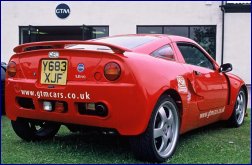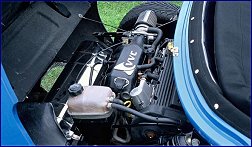|
Keen to get into the
dry, we found our way back to the front of the building and into the
warmth of the showroom where we were presented with three Libras and a
Spyder. Before long, one of the original partners, Paddy Fitch, had
greeted us, offered us coffee and before disappearing to brew up, urged us
to take a good look at the cars on show.


The first car we
started examining was a red Libra powered by a 1.8 K series engine and
fitted with the optional stainless grille set. Settling down into the
figure hugging Cobra bucket seats proved an interesting task for someone
more recently used to the ergonomics of a sports saloon. Once cocooned
inside the cabin, the first impression was of a tardis like interior.
Externally, the Libra appears to be a very compact sports car with its
almost non-existent overhangs front and rear and steeply raked bonnet.
Internally, passenger leg room is vast and the mid-engined configuration
removes the need for a large, high transmission tunnel separating the
cockpit as found in many kits. The only apparent downside to the
innovative packaging is the marked offset of the pedals, forced inboard
due to their location level with the front offside wheel arch. This
particular car is fitted with the GTM instrument pack and a small diameter
Sabelt steering wheel. Although adding to the sporty ambience of the
cockpit, it is a little too small in my opinion – the rim of the wheel
obscuring the outer parts of the instrument binnacle.
Pulling on the cord
door release and climbing out over the sill proved easier having moved the
seat back on it’s rails, the door opening wide enough to prevent too much
difficulty. Having extracted ourselves from the interior, drawn by the
return of Paddy complete with mug of steaming coffee, our attention was
once again drawn to the exterior. Looking through the Perspex rear screen
at the Rover engine mounted just in front of the rear axle, conversation
came around to engine choice. I had already discounted engines smaller
than the 1.8 in my quest for high octane fuelled thrills, so the question
in hand was how to choose between the 1.8 VVC (158bhp [160PS]) and the 2.5
KV6 (175bhp [177PS]). Although the KV6 is found in 190PS form in the MG
ZT 190, this is apparently mated to a heavier Getrag ‘box, whereas in
177PS form in the MG ZS it’s mated to the lighter aluminium PG1 ‘box made
by Rover’s Powertrain Ltd. transmission subsidiary themselves. Walking
into the showroom my thoughts were swaying rapidly towards the torquier
KV6, especially as I intend to use the car for daily transport including
motorway miles, the logic of a V6 pulling a longer gear at lower revs
pointed towards better refinement. For the same reason, and those of
cost, I had already considered and dismissed the VHPD 1.8 (190bhp) and 2.0
K2000 (250bhp @ £12,900 + VAT new from Engine Developments Ltd.
http://www.engdev.com/). Paddy pointed out that along with a more
expensive kit due to changes required to the monocoque chassis and
bodywork, the actual engine and ancillaries add more to the overall cost.
The figure quoted was approximately £3,500 which is a lot of money for a
little more refinement – the additional power is swallowed by the
increased weight resulting in almost identical power to weight ratios in
the region of 220bhp/tonne and similar performance with the 62mph
benchmark coming up in both in around 5.5 seconds. When Paddy revealed
that this non-VVC car had returned over 50mpg on the trip down to the
Exeter show and back, the case for the 1.8 began looking ever stronger.
Coffee duly
consumed, Paddy guided us through to the assembly workshop where there
were two export market Libras in differing states of completion (along
with a Ford escort undergoing rhinoplasty in the form of a new front
bumper). The first car, destined for Australia, was little more than the
98Kg monocoque fitted with front and rear suspension, pipes and wires
emerging from everywhere, a daunting site for a kit-car virgin considering
the Libra as a first build. Seeing the chassis in this state reminded me
of a picture posted up to the PistonHeads kit car forum depicting a Libra
sat in the middle of a French motorway having been rapidly disassembled
from complete car back to bare chassis in a 3 figure speed spin on the way
to Le Mans. Testament to the strength of the pure composite monocoque is
that both driver and passenger walked away from the high speed spill.
More recently, this driver has been in discussions with GTM about buying
a replacement – something that speaks volumes about the car.


The other part built
example is to be fitted with a Honda VTEC engine once shipped out the
United States. The use of Japanese power certainly seems to be a popular
development at the moment with Lotus recently announcing Toyota power for
US market Elises and global Exiges. GTM see the fitting of this
federalised power source as being key to opening up the international
market. This car was in a much more advanced state of completion with all
body panels fitted, wheels and tyres and even some of the interior trim in
place. GTMs technicians take an average of 200 hours to complete a
standard Libra build in the workshop while kit customers are expected to
take around 250. Paddy highlighted the fact that there are almost always
cars in the workshop at various stages of completion and customers are
welcome to turn up as often as possible to get advice and take pictures of
how the assembly in question should look when correctly installed.
Oily bits duly
inspected, we returned to the showroom to take a further look around the
cars on show. Moving on from the red 1.8, we took a look at the yellow
1.8 recently acquired by GTM from a previous owner to use as next year’s
demonstrator. This particular car had been fitted with a somewhat dubious
rear spoiler and slightly more appealing front splitter complete with
angle adjustors to complete the street racer feel. The final Libra on
display was a maroon car with a unique interior with red white and blue
striped padding on the door trim panels and alcantara trim on top of the
dash in place of the more common leather cloth.
Inspired by the
unusual finish of this car and the many photographs of the black V6 GTM
that adorn the walls of the showroom, we began talking about the exterior
colour of the monocoque. All Libra chassis are gel coated before leaving
the factory giving them a fully prepared colour without the need to spray
paint. The best colours to choose for this are apparently the lighter
ones, with white being the best and black the worst. The explanation is
that lighter colours reflect the sunlight whereas darker colours, black
especially, absorb the heat, baking the composite which causes the fibres
to move and show through the gel coat. One possible mitigation discussed
is to allow this baking process to occur and once complete to spray the
body, covering any newly apparent imperfections.
Having taken in the
styling and engineering of the Libra, our attention turned to the more
practical aspects of ownership. Storage space is split between the area
behind the seats and a boot built into the engine cover. The boot in the
engine cover is waterproof, lockable and out of sight. The main purpose
of integrating this into the design was to provide storage space for
valuables that placed them out of sight of any nefarious characters that
might see a laptop behind the seats as an invitation. The boot is a
reasonable size for soft bags or indeed, as stated in GTMs literature and
so often the measure of a cars boot space, golf clubs. Behind the seats
there is ample room for a couple of soft bags or hold alls, or perhaps the
weekly shop on a more mundane journey. Both these storage areas are
diminished in the case of the KV6 engined cars due to the increased with
of the cylinder heads. This results in a loss of about 6 inches in the
length of the boot and a protrusion into the load area provided between
the seats.
The final vehicle in
the corner of the showroom was a blue Spyder, the new convertible version
of the Libra. Of course referring to it purely as a drop top derivative
fails to convey the engineering challenges involved in cutting out the
roof from a monocoque chassis. In the case of the fixed head Libra, the
exceptional torsional stiffness of 14,000Nm/deg (with windscreen in place)
is in part down to the bracing provided by the roof structure. With this
structure removed, additional strengthening had to be added to the chassis
in other places, resulting in an overall increase in 30Kg to the weight of
the monocoque.


Discussing the
modifications made to the Spyder, including the new styling details to the
bonnet and rear of the car by Richard Oakes, Paddy pointed out that the
development that has taken place on the Spyder is in many cases
transferable to the Libra. As an example GTM now offer the option of a
Spyder bonnet when ordering a Libra kit. Although no new models are even
on the drawing board at this stage, development work on the Honda VTEC
powered model for the USA will no doubt offer more modifications and
enhancements that will become available on the rest of the Libra and
Spyder range.
Despite no let up in
the abysmal weather, Paddy offered to take me out for a demonstration
drive along the local country roads surrounding the factory. With the
yellow spoilered Libra extracted from the extremely narrow showroom
doors we made our way out onto the open road, narrowly missing a banzai
postie as he swung his van into the factory grounds. On the road I was
informed that the suspension was set somewhere in the mid range offered by
the fully adjustable Avo coil-overs. The roads were drenched, precluding
any hooliganism other than a few judicious prods of the loud pedal once
all four wheels were firmly pointing in the same direction. This was
enough to give a good impression of the performance in reserve even
without the full grunt of the 160PS VVC power plant. Despite the
appalling conditions, the chassis felt very composed on both the smoother
A roads and the less than perfect tarmac leading right back to the
factory.
To GTMs credit, it
wasn’t until this very late stage that any sign of a sales patter became
apparent. On the way back to the factory Paddy asked if I could be
tempted to put down the £300 deposit there and then to secure a delivery
date some time in February. As tempted as I was I thought it best to
consider my options in the cold light of day and take my time making my
final decision over engine choice. Paddy seemed happy with this and made
no further attempt to push the matter.
Before bidding our
final farewells Paddy gave us details of the recommended engine and donor
supplier, brochures and price lists for the Libra and Spyder. Saying our
goodbyes we ended what I am sure will not be our last visit to the GTM
factory.
|